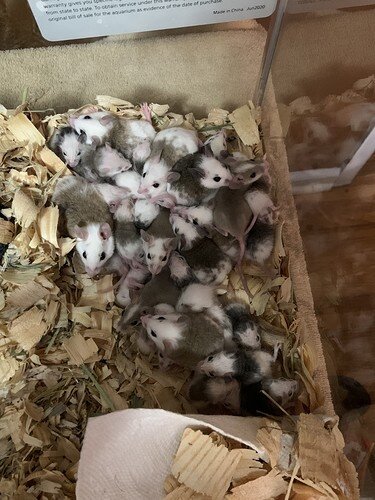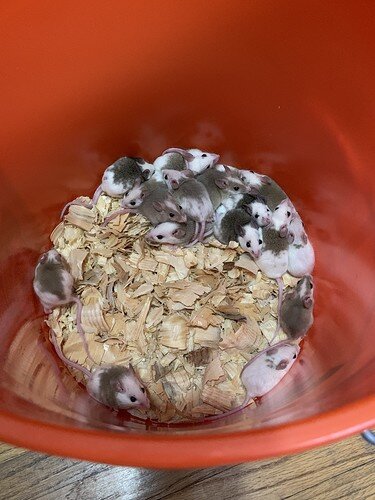1.6 is fine. We only do one male per bin and it seems to work well
Ok. Good to know. I only have 4 bins to work with currently so I plan on feeding off the smaller colonies. Only got 6 BPs currently to feed. Altho I could just cull the extras and freeze them for later, or sell them off.
Just keep in mind they take a bit longer to grow then mice and rats so it’s usually a good idea to build up a little inventory before making the switch over to feeding them off as some animals will become “hooked” on them. You can switch back and forth from asfs to reg rats for a while as you build up your colony. Congratulations on your 1st litter.
Thanks. Right now my plan is feed off 2 males from the large colony, and the males from the small colonies. Let the females from the small colonies raise their litters for a month before feeding the females off. Then sticking to just one large colony and using the other bins for grow out. I will wait until I have a healthy supply of grow outs before making the full switch.
Have gone from my original colony of 1.3 to around 60 since the last week of February. Pulled a couple more litters out today.
And my male grow outs from my first litter are 10 weeks old and all around 70grams so I was able to feed a few off to my BPs this week. Can’t keep up!
It’s much more a case by case basis as is true with BPs in general some are just “picky.” By and large there should be no problem with feeding back and forth from ASF to Norwegians. Just depends on the snake. No different from those weirdos that only eat a certain color rat etc.
Really just depends on the quality of your line behavior wise. A less aggressive line or one you’ve selectively bred for generations should have no problems with multiple male colonies.
Definitely nothing wrong with playing it safe if you aren’t sure or if you had issues in the past.
If you are stuck with an aggressive line or one with major chewing or other behavioral problems I’d strongly recommend culling and starting over from a different source.
It’s like a completely different animal working with a better line.
Ok…so I need some advice. The large colony I got. I thought was 3.6, so I fed off two of the males to make it 1.6. The next time I went to clean the bin, I noticed that the colony was actually 2.5. So I fed off the extra male to make it 1.5. Well now I have one of the females give birth to a litter, and now the females seem to be fighting the male. I noticed he has dried blood in his ears, and a little bit of blood dripping down his face. From what the previous owner told me, they were housed together as pets. So I am unsure why they are fighting. When I watch them, they seem fine, although the male is in the opposite corner away from the females. When I walk away, it seems like the bin is rocking all over. Should I remove the male and just have one of the male babies take over?
As a side note…I added a spinning disk so they can burn off the extra energy, and it was extremely funny watch the next female to pop a litter woddle/run on it.
Also. None of the females seem hurt. Just the male.
My experience with these guys is limited for now but from going through pretty much the exact same experience, yeah I would go ahead and move him. They are relatively calm animals but once they kick one out of the group its unlikely to get back in alive.
We have the same problem, the females kept attacking the male and now we don’t have any to breed or anywhere to buy them from.
Once they have decided to kick one out, they will eventually kill it if not removed. But note you won’t be able to re-introduce him either
Alright. I removed him a little after posting. It seemed like only one female was attacking him, and I’m sure it’s not good for the rest to be stressed like that. I also went and gave them a clean bin to raise their new litter. Noticed one of the 6 babies wasnt alive. Seem to also be having 3 week old babies passing as well in another colony. Two within a few days of each other. Unsure why.
You probably killed the sire of the litter amd that’s why she was attacking the other male. The babies might have just been trampled in the melee or killed/ignored due to the stress. ASF breeding can be quite annoying sometimes
I started out with 3 - 1.5 colonies, then down to 1.4 and now I’m down to 1.3. What I found, at least with my groups, is that if I have too many females that all litter at the same time, I have had more babies not make it. I’m currently down to only one colony of 1.3 and pulled the males from my other 2 breeding groups so that I can restart and also slow down on the amount of dang ASFs I’m feeding. My snakes can’t keep up with how many I have and how many are growing. And for some reason, I’m having trouble finding a buyer for my excess. So if anyone has any tips on that front, I’d love to hear them.
I agree that likely the sire was removed and the female was not interested in having another male around. Once a female has bred, putting a male with her (unless its a male that grew up in the tub) will end in bloodshed. I’d recommend, when the litters are moved to their grow-out tubs, keeping a male from one of the litters in with the females. Or, an even better route would be to start a whole new colony with the offspring. 6 babies is a pretty small litter size for ASFs and it is possible that the adult females are far past their prime and will need to be cycled through anyways. You’d want to do that sooner rather than later.
After multiple generations, I can stick my hand in their tub and they have become quite docile. I quickly culled the biters and I now have a thriving population. Let me know if you have any additional questions! Good luck!!
I have been searching for ASFs but I haven’t found a seller near me  I have one colony left in which I’m hoping will breed when they reach age and I’m going to keep every offspring for a while, hopefully that will work
I have one colony left in which I’m hoping will breed when they reach age and I’m going to keep every offspring for a while, hopefully that will work 
I find the females tend to attack the male when babies have been born.
We never had this issue prior to last year, but our mice did the same also
Now my oldest litter has had 5 out of 10 pups just randomly pass. They just hit 3 weeks this pass Thursday and I’m so confused as to why it is happening. All within the pass few days.
So far I have another litter a week behind them in another tub with one mother and they are going strong, and another of my other tubs just popped 13 today.
What are you using for substrate? Do you notice the babies feeding regularly? Your females might be having lactation issues.
I use the same stuff as CD Exotics that was in her video. Pine shaving, and pine pellets that are kiln dried from tractor supply. I do notice that the litter that is a week younger then them are about the same size or bigger in another tub with only one mother feeding them. I have a bowl of food on floor with sunflower seeds and mealworms. I started putting the mazuri food in the bowl as well, and I put their hide underneath the water since it is a little high. I plan on hitting up home depot or lowe for some 2x4 pieces to use as something for them to climb up on that is a little heaver then the hide. The adults keep moving it around.
Hello! So I went through my two litters that were ready to wean. The first group only had three out of ten still alive and they look pretty bad, they are a month old. The second litter which had twelve strong healthy looking weans I went and removed from the mothers and put them in their own bins separate for (7) males and (5) females, which they were three weeks old. I want everyone’s opinion on the three from the first group. I was going to move them in the grow outs with the others, but I think maybe it is best to quarantine them because they are lacking fur. The one pictured below is the worst of the three, but the other two are not far behind… Has anyone experienced this before? I believe the female that dropped this litter was a little older and a known breeding female from the breeder I got them from. Not sure if age would produce issues… The second litter that is strong and healthy is also from the same breeder, but I think a first time mother.
It looks more like barbering than something contagious to me me, but it’s hard to tell from the picture. I have a mouse strain that consistently does this too and since I’m not a rodent expert, I’m not sure why. Do they seem stressed? Is the cage too crowded?
Barbering is an aggressive behavior in rodents. They aggressively groom the other basically to show dominance. Sounds like they have aggressive females that might need culled later to keep from producing more aggressive ASF.


